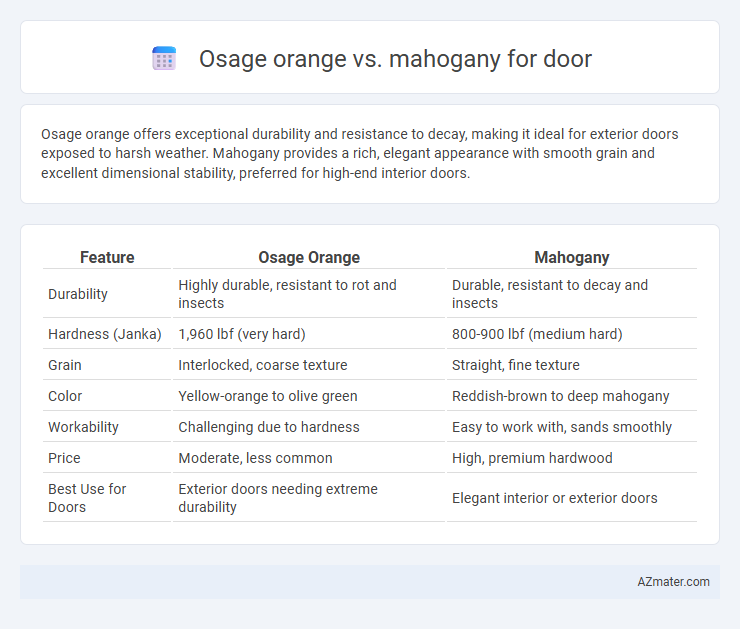Osage orange offers exceptional durability and resistance to decay, making it ideal for exterior doors exposed to harsh weather. Mahogany provides a rich, elegant appearance with smooth grain and excellent dimensional stability, preferred for high-end interior doors.
Table of Comparison
| Feature | Osage Orange | Mahogany |
|---|---|---|
| Durability | Highly durable, resistant to rot and insects | Durable, resistant to decay and insects |
| Hardness (Janka) | 1,960 lbf (very hard) | 800-900 lbf (medium hard) |
| Grain | Interlocked, coarse texture | Straight, fine texture |
| Color | Yellow-orange to olive green | Reddish-brown to deep mahogany |
| Workability | Challenging due to hardness | Easy to work with, sands smoothly |
| Price | Moderate, less common | High, premium hardwood |
| Best Use for Doors | Exterior doors needing extreme durability | Elegant interior or exterior doors |
Introduction: Osage Orange vs Mahogany for Doors
Osage Orange wood is highly prized for its exceptional durability, natural resistance to decay, and distinct bright yellow to orange hue that deepens over time, making it an excellent choice for exterior doors exposed to harsh weather. Mahogany, known for its rich reddish-brown color, fine grain, and smooth texture, offers superior workability and a luxurious finish favored in high-end interior and exterior door applications. Both woods provide strength and aesthetic appeal, but Osage Orange excels in longevity and toughness while Mahogany delivers elegance and ease of customization.
Wood Origin and Description
Osage orange, native to the south-central United States, is prized for its extreme density, bright yellow heartwood, and natural resistance to decay, making it a durable choice for exterior doors. Mahogany typically originates from Central and South America and is valued for its deep reddish-brown color, fine grain, and smooth texture, offering an elegant appearance for interior doors. Both woods provide excellent stability, but Osage orange's unique toughness contrasts with mahogany's luxurious aesthetic qualities.
Durability and Lifespan Comparison
Osage orange offers exceptional durability with high resistance to decay, insects, and weathering, making it an ideal choice for exterior doors exposed to harsh conditions, often lasting 50 years or more with minimal maintenance. Mahogany, prized for its rich color and fine grain, also provides substantial durability and natural resistance to rot and pests, typically sustaining a lifespan of 40 to 60 years when properly finished and maintained. Both woods deliver long-lasting performance for doors, but Osage orange's superior hardness and decay resistance generally result in a longer lifespan in outdoor environments.
Appearance and Grain Patterns
Osage orange doors exhibit a vibrant golden-yellow to bright orange hue that darkens over time, featuring a fine, interlocked grain with striking flecks and a rugged texture that enhances rustic or contemporary styles. Mahogany doors showcase a rich, deep reddish-brown color with uniform, straight, and fine grain patterns, offering a smooth surface ideal for elegant or classic door designs. The distinct contrast between Osage orange's bold, textured character and mahogany's refined, consistent grain makes material selection crucial for matching aesthetic preferences and architectural themes.
Hardness and Strength
Osage orange exhibits exceptional hardness with a Janka rating of approximately 1,290 lbf, making it highly resistant to wear and impact, while mahogany typically ranges from 800 to 900 lbf, indicating moderate hardness. In terms of strength, Osage orange is known for its dense, interlocked grain structure, providing superior durability and resistance to deformation compared to the relatively softer and more workable mahogany. These characteristics make Osage orange ideal for exterior doors requiring high strength, whereas mahogany suits applications where moderate strength and aesthetic appeal are prioritized.
Weather Resistance and Stability
Osage orange exhibits exceptional weather resistance due to its dense, rot-resistant heartwood, making it ideal for exterior doors exposed to harsh conditions. Mahogany offers excellent dimensional stability across varying humidity levels, reducing warping and shrinkage in door applications. Both woods provide durability, but Osage orange's superior resistance to decay and moisture makes it more suited for long-term outdoor use.
Workability and Finish Options
Osage orange wood is renowned for its exceptional workability, allowing easy cutting, shaping, and sanding, which makes it ideal for custom door designs. Mahogany offers a smooth texture with excellent finish options, providing rich, deep hues that enhance door aesthetics through staining or clear coatings. Both woods respond well to finishing; however, mahogany's natural oil content allows for a more polished and durable surface compared to Osage orange.
Cost and Availability
Osage orange is more affordable and widely available compared to mahogany, making it a cost-effective choice for door construction. Mahogany, prized for its rich color and durability, commands a higher price due to limited supply and high demand. The cost difference is significant, with Osage orange typically priced at a fraction of mahogany's market value, influencing availability for large projects.
Maintenance Requirements
Osage orange doors require minimal maintenance due to their natural resistance to rot, decay, and pests, making them highly durable in various weather conditions. Mahogany doors, while offering a rich, elegant appearance, need regular sealing and refinishing to protect against moisture and UV damage. Proper maintenance of Mahogany involves periodic sanding and applying protective coatings to preserve its color and prevent warping over time.
Best Applications: Which to Choose for Your Door
Osage orange is best suited for exterior doors due to its exceptional durability, resistance to decay, and vibrant yellow-green hue that weathers beautifully, making it ideal for harsh climates. Mahogany excels in interior door applications, prized for its rich, reddish-brown color, fine grain, and ease of finishing, providing a luxurious and elegant appearance. Choose Osage orange for strength and weather resistance on entry doors, while Mahogany offers superior aesthetics and smooth texture for interior or decorative doors.

Infographic: Osage orange vs Mahogany for Door
 azmater.com
azmater.com